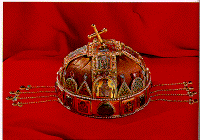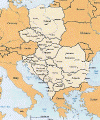





Actually two crowns hammered together in some haste, perhaps contributing to the bent cross. The lower part was a gift from the Byzantine emperor and the upper part from Pope Sylvester II.
Here is part of an account of the history of this crown from the
Mississipi State University History Site :
There is no other nation in the world, who would keep in such
a high reverence, have such a high respect for, love with such a
mystical adoration their national relic as the Hungarians do with
their crown, the Hungarian Holy Crown. There is no other nation to
be found, whose national relic's source, origin and age are so much
unanswered, surrounded with such a mystery, and went through such
fantastic adventures as did the crown of the Hungarians. Believed
to be the crown of the first Hungarian king, Saint Stephen I.
(1000-1038), this crown was pawned or lost, stolen or seized,
stashed or rescued and was kept in more royal courts, towns,
castles and citadels than any other nation's coronation jewel. Wars
were waged for this crown and it happened that it was dug
underground in a iron chest or in a crude oil barrel. Every time
the Holy Crown returned to Hungary, it brought about an elevated
emotional, solemn atmosphere in the entire country, and its power
was so enormous over the nation that the people knelt down before
the coach carrying the crown, as they did later before the train
bringing home the remains of Louis Kossuth.
The above examples meant to say that the Holy Crown was not
only a crown for the Hungarians. It represented something much
bigger and universal. The Holy Crown had divine power for them and
symbolised the whole kingdom, the territory of the country, the
entire Hungarian nation. That is why it was more important than
anything else for the Hungarians to rescue and safeguard the crown
in decisive historic periods, because if there was no Holy Crown,
there was no Hungary. This is the reason why king Bela IV. rescued
it to the fortress of Klissa (Croatia today) from the Tartar
invasion (1241), king Matthias bought it back from Vienna for an
astrological [astronomical] price (1463), Peter Perenyi hid it in his citadel of
Fuzer from the Ottoman invasion (1526), Louis Kossuth dug it
underground in an iron chest near Orsova (Rumania today) after the
surrender to the Habsburgs at Vilagos (1849) and Ferenc Szalasi
rescued it to Austria from the invading Red Army and dug it
underground in an oil barrel (1945). These historic events are only
few examples from the horrendous adventures the Hungarian Holy
Crown went through but they all deliver the same message, i.e. as
long as the Holy Crown is safe and exists, Hungary is safe and
exists.
The unique role the Holy Crown had in the Hungarian history
brought about the development of a doctrine called the "Holy Crown
Theory". Initiated by king Kalman the Booklover (1095-1116), this
theory holds that the utmost ruler of Hungary is not the king but
the Holy Crown. In the kingdom, everything, i.e. country, towns,
lands, belong not to the king but to the Holy Crown. The ultimate
power is not that of the king but the crown's and, for example, if
a dynasty died out, their land did not return to the king (where it
came from) but to the crown. The territories which joined Hungary
(Croatia, Dalmatia, Sclavonia, Rama [Bosnia], Serbia, etc.) were known as "Land of St Stephen's Crown".
In 1945, the US Army seized the Hungarian Holy Crown, and
according to a statement No 687, issued by the State Department in
1951, the US Government did not consider it as a spoils of war but
stored it as a deposit. The Holy Crown was kept in Fort Knox, KY,
the same place where the US keeps its gold treasure, and it finally
returned to Hungary on January 5 1978, when State Secretary Cyrus
Vance transferred it to the possession of the Hungarian Government.
The two parts, the lower circular greek crown and the upper
arch-type latin crown was attached together by Hungarian king Geza
I. at the end of the 11th century, and it is proven that the
complete Hungarian Holy Crown already existed in 1166. So, it is
more than 800 years old.
The Hungarian Holy Crown is a harmonic complex of many styles
of art, fine goldsmith's and artistic works, so it truly counts for
a masterpiece. Apart from that, it represents their country, nation
and culture for the Hungarians, and such, it is much more than just
a regal jewel for them, it is their highest regarded national
relic. If the Holy Crown were able to speak, it could tell all the
ups and downs, despairs and hopes, anguishes and happiness, cares
and cheers the Hungarians went through with their crown during
their history which made them, the Holy Crown and the nation, two
unseparable parts.
St Stephen's Crown

 Verdicts were declared in the name of the Holy Crown and not the
king, and during those troublesome times when the country had no
king, the civil leaders swore in for the Holy Crown. (The final
form of the "Holy Crown Theory" was drafted and published by
Stephen Werboczy, a jurist, in his book called Tripartium, 1517,
Vienna).
Verdicts were declared in the name of the Holy Crown and not the
king, and during those troublesome times when the country had no
king, the civil leaders swore in for the Holy Crown. (The final
form of the "Holy Crown Theory" was drafted and published by
Stephen Werboczy, a jurist, in his book called Tripartium, 1517,
Vienna).
 Back to TWC's Mad Rush Homepage
Back to TWC's Mad Rush Homepage
 Please email your comments to weecheng@post1.com
Please email your comments to weecheng@post1.com